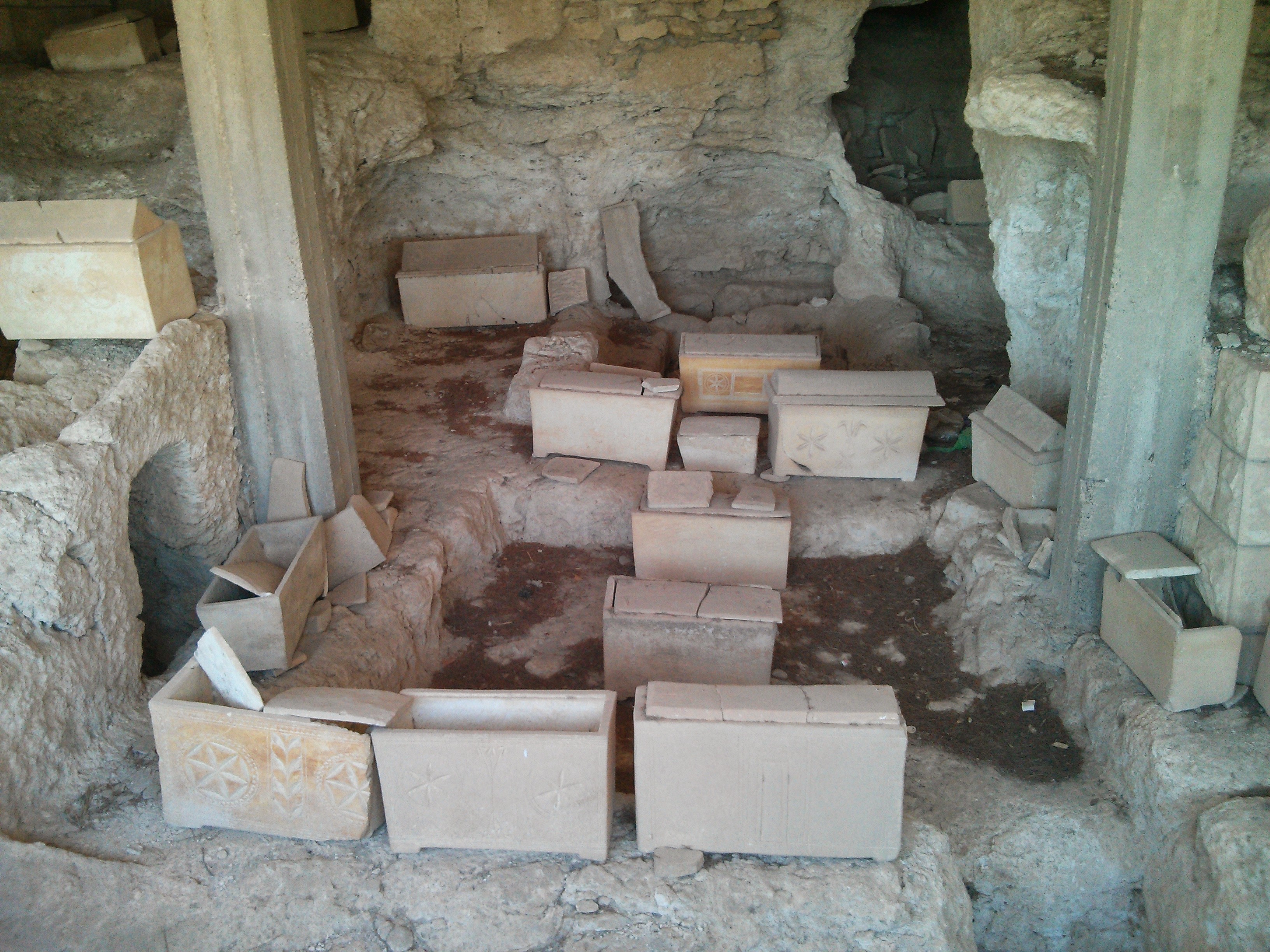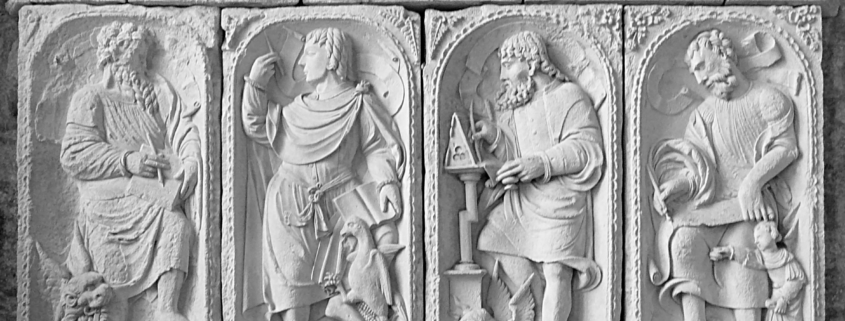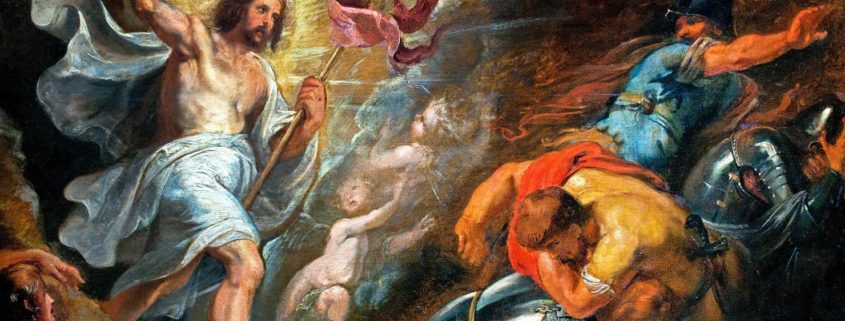Cale explains the shockingly powerful message of the Gospel of Mark, a truly revolutionary document that changed the world. For more on this topic, see this post.
Posts
(My latest for Catholic Answers Magazine.)
When were the Gospels written?
You might respond with a question of your own: “Who cares?” Or, “Why does it matter?”
Here’s one reason why: some skeptics are claiming that the Gospels are unreliable accounts of Jesus’ life because they were written too long after the fact. They then use the alleged unreliability of the Gospels as a weapon against Christianity.
For example, the quite popular (and quite skeptical) New Testament scholar Bart Ehrman states in his book How Jesus Became God that the Gospel authors had no intent of presenting “biographical information” concerning “what Jesus really said and did.” Skeptics like Ehrman maintain that accounts of Jesus’ career were passed down orally for many decades before they were ever written down in the Gospels, leaving them open to be embellished until they bore little to no resemblance to what actually took place during Jesus public ministry during A.D. 30-33. To their reckoning, the process of Gospel composition was like the children’s game of Telephone, in which a message, whispered from one ear to another, gets changed many times before it reaches its final destination. This despite the evangelists’ claims to be reporting the truth about Jesus’ career (cf. Luke 1:1-4; John 19:35, 21:24-25).
Ehrman contends, along with the majority of modern textbooks on the New Testament, that the Gospels were composed decades after the life of Christ, with Mark circa A.D. 69-70, Matthew and Luke in the 70s or possibly the 80s, and John in the 90s, possibly as late as 95. Ehrman is sure that the forty- to sixty-year gap between Jesus’ life and the appearance of his biographies lessens the probability that they preserve accurate information about him.
But there is another view, long dormant, that is reasserting itself on the scene: the idea that, just maybe, the Gospels were written much earlier. Years ago, the scholar John A.T. Robinson claimed that the entirety of the New Testament was composed prior to A.D. 70! Why? For the simple reason that not one of the twenty-seven New Testament books mentions the destruction of the Jerusalem Temple by the Romans in that year—a cataclysmic event of cosmic significance for Jews.
Now, I can hear what some of you are saying: “But Jesus prophesied the destruction of the temple!” True, but it wasn’t prophecy ex eventu (“after the fact”), with the Gospel writers reading some recent event back into Jesus’ words years before. (If that was the case, the evangelists did a terrible job.) No, this was real prophecy, for Jesus spoke of the temple stones being “thrown down,” whereas the temple was actually burned to the ground. If the Gospel writers were aware of how the temple actually was destroyed, they might have mentioned that, because fire is a well-known biblical image of judgment.
It defies belief that no New Testament book, if written after the year 70, would have mentioned the temple’s decimation in clear fashion, especially given the role of the temple authorities in Jesus’ death. (Hebrews 13:10 implies that the temple is still standing at the time of its writing: “We have an altar from which those who minister at the tabernacle have no right to eat.”) If the temple really had been lying in ruins when the New Testament writers put ink to scroll, the temptation to say, “Hey, here’s God’s judgment on the temple authorities for what they did to Jesus!” would have been too great to ignore.
And there are other reasons the Gospels might have been written earlier. The Acts of the Apostles leaves off with Paul in Rome under house arrest, awaiting trial. It’s highly doubtful that Luke, the author of Acts and traveling companion of Paul, would not discuss the martyrdom of the book’s central figure—not to mention that of Peter, who was also martyred circa A.D. 64 under the Neronian persecution. So there’s a good case to be made that Acts was composed pre-70; in fact, pre-64!
We also know that Acts is part two of Luke’s “two-volume set,” as it were, with the Gospel of Luke being part one, so obviously Luke’s Gospel had to come even earlier. And, if Mark was indeed written prior to Luke, serving as a source for that Gospel and for Matthew (as most scholars believe), Mark must date earlier still.
And don’t forget that Paul’s letters, which corroborate many facts about Jesus’ life, were probably written prior to any of the Gospels.
Now, if the Gospels really were written later, as Ehrman and many scholars assert, it doesn’t necessarily follow that they are historically unreliable. But we’d probably all agree that the closer in time a document is written to the events it covers, the more likely it is that it’s accurate and, just as importantly, can be verified by others.
An experience I had might help us to understand this. While visiting the Catholic Answers offices in San Diego not long ago, my family and I took a side trip to see Torrey Pines, the gorgeous golf course that hugs the Pacific coast. Not far from the course we stumbled upon a beautiful veterans’ monument, honoring those who had given their lives in service to their country. Many of those memorialized had served in the Vietnam War, which ended in 1975. Of course, many veterans of that conflict are still alive today, with still-vivid memories of their tours of duty.
This all reminded me of an insight from the Evangelical writer Greg Monette: the period of time that has elapsed since the Vietnam War until the present day is pretty much exactly the same time frame that elapsed—if the earlier dates are right—between the public ministry of Jesus and the time when the Gospels were likely completed and circulating: about forty years. Just as someone today offering an erroneous, fictional account of the Vietnam conflict could be discredited by the testimony of those who were actually there and lived through the experience, the controlling influence of eyewitnesses to Jesus’ ministry would have prevented the Gospel writers from fabricating events from Jesus’ career that never really happened.
Even if the Gospels had been written later, on Ehrman’s timeline, that would be about the same gap from World War II to the present day. Just as there aren’t as many World War II vets still living as Vietnam vets, there are still some who could be interviewed. Paul noted in 1 Corinthians 15:6 that many of the over 500 individuals who witnessed the resurrected Christ on one occasion were alive, and ostensibly willing to be consulted. New Testament scholar Robert McIver contends that there would have been up to 63,000 potential adult witnesses to Jesus’ public career, with 18,000 to 20,000 still living after thirty years (which would correspond to the earlier dates of Gospels composition) and between 600 and 1,100 within sixty years (the later dates). An early apologist named Quadratus, who lived from 70-130 AD, also claims that eyewitnesses to Jesus were alive in his day.
As the Acts of the Apostles notes, “This was not done in a corner” (Acts 26:26), or in a galaxy far, far away. Whatever the exact dating of the Gospels, Jesus’s ministry was a public event whose chroniclers were intent on accuracy and whose witnesses were not going to stand by to let what they had seen and heard be swallowed up in legend.
Here’s my latest piece for Catholic Answers. Hope you enjoy it. — Cale
Every Easter season we encounter articles, documentaries, books, and news reports suggesting that the canonical Gospels got the Resurrection wrong. Scholars with impressive credentials appear in the media to tell us that, if we want the full story about Easter, we must turn to what are known as the apocryphal Gospels.
It often comes as a surprise to Christians to learn that there were many other “Gospels” that circulated in the decades and centuries after the composition of Matthew, Mark, Luke, and John, but never made it into the New Testament. Some of these have survived to our day, to the fascination of scholar and layman alike. But do these works indeed provide credible information about Jesus that isn’t in the Bible?
A professor of mine always gave this advice to students who were curious about these writings: “Just read them,” he said, “and ask yourself this question: do you really think they smack of authenticity?” Some of the scholars who champion the apocryphal Gospels imply that the Church hid these documents from the people because they contain the “real” story about Jesus. But reading them, as Dr. Evans knew, shows that the Church had very good reasons for not canonizing these works. Far from radiating authenticity, they come across as quite strange and not reliable historically.
Let’s take one example of these texts, the Gospel of Peter, and compare its Easter narrative to that in the Gospel of Matthew.
Matthew’s account of the Resurrection, written in the first century, is sober and rather restrained—especially compared with the account in the Gospel of Peter, a highly embellished collection of legends likely written in the second century. (No, it wasn’t actually written by Peter, don’t worry—later writers would attribute their works to apostles in an attempt to gain credibility).
Far from being an early, original source of material on the life of Jesus, the Gospel of Peter is actually dependent on the canonical Gospel of Matthew for much of its content. Its unbelievable reworking of the Resurrection account in Matthew includes—get this—a talking cross that emerges from Jesus’ tomb along with the risen Jesus and two angels, all of whom are so tall that their heads are, quite literally, in the clouds (39-43). It also mentions many other elements that a Jewish audience would find implausible and ahistorical, such as members of the Jerusalem religious elite pitching tents and sleeping among the tombs with Roman soldiers, making sure Jesus stays dead (33, 38). Ever heard of uncleanness and ritual impurity? Hello!
The Gospel of Peter therefore lacks what is called verisimilitude. Its miraculous details seem purposely fantastic. It doesn’t cohere with the way things actually were in Jesus’ time and place. Readers of Matthew’s Easter account, especially those of a Jewish background, would have found its Easter account much more credible and persuasive. Let’s look at some of its details.
Facets of Matthew’s account of Jesus’ burial later become important proofs for Jesus’ resurrection. The mention of Joseph of Arimathea’s donation of a new tomb for Jesus burial (Matt. 27:57-61) is significant. Joseph, who is mentioned in all four Gospels and undoubtedly a historical personage, was a member of the Sanhedrin, and thus a known public figure. This means that the location of Jesus’ tomb was also known to friend and foe alike. If Jesus’ remains were still entombed following Easter, it would have been easy to prove this by searching Joseph’s tomb. However, even the enemies of the nascent Christian movement do not dispute the empty tomb (Matt. 28:11-15). Matthew also notes that many of Jesus’ women followers saw the place where Jesus was buried (27:56; 27:61; 28:1-8), discrediting any theory that the women went to the wrong tomb on Sunday morning.
Among the canonical Gospels, only Matthew’s mentions the presence of Roman guards at the tomb, a point that many critics of the Gospel dispute. The Gospel of Peter also mentions the guards, though again with legendary accretions. Even so, this demonstrates that the guard account was an enduring aspect of the apologetic for the Resurrection. Therefore it is more certain, from a historical perspective, that guards were in fact present.
The chief priests, after hearing “everything that had happened” from the guards, bribed the soldiers to propagate the story that the disciples of Jesus stole his body from the tomb while they slept (a first-century edition of “fake news,” one might say). Matthew reports that, at the time of the writing of his Gospel, this version of events was still being told among the Jews (Matt. 28:11-15). In fact, this story became a well-entrenched facet of an anti-Christian Jewish apologetic, for Justin Martyr, writing in the second century A.D.,states that it was still being circulated in his time.
The guards’ probable historicity is even further bolstered by the edict of Caesar, possibly enacted in Galilee in the first century, decreeing capital punishment for grave robbers. The fact that tampering with Jesus’ tomb would have been punishable by both Jewish and Roman authorities, and that the tomb, according to Matthew, was sealed (Matt. 27:66), make any potential moving of Jesus’ body from the tomb highly unlikely in this case.
Add to that the fact that liars usually make terrible martyrs (why would the disciples later die for their belief in the Resurrection, if they had in fact stolen the body?), and one has a very solid case for the empty tomb. Again, even the enemies of the Christian movement admit the tomb is empty, and enemy attestation is excellent evidence.
But, of course, an empty tomb alone does not a resurrection make. This is why Matthew’s accounts of the appearances of the risen Jesus are so important. That Mary Magdalene and the other women “took hold of his feet” (Matt. 28:9) affirms the corporeal (bodily) nature of Jesus’ resurrection, making the same point as Luke 24:36-43 and John 20:24-29.
Matthew’s very mention of women as the first to discover the empty tomb on Sunday morning, encounter the resurrected Jesus, and inform the male disciples of the event is, in all likelihood, historical. Given the (unfortunately) very biased and low view of the testimony of women in both Jewish and Greco-Roman settings of the time, Matthew (and the other Gospel writers) would never have mentioned this unless it was factual. Consider these quotes from Jewish sources of the general period:
Sooner let the words of the Law be burnt than delivered to women (Talmud, Sotah 19a).
But let not the testimony of women be admitted, on account of the levity and boldness of their sex…since it is probable that they may not speak truth, either out of hope of gain, or fear of punishment (Josephus, Antiquities 4.8.15).
Any evidence which a woman (gives) is not valid (to offer)…This is equivalent to saying that one who is rabbinically accounted a robber is qualified to give the same evidence as a woman (Talmud, Rosh Hashannah 1.8).
The bizarre Gospel of Peter instead describes many prominent maleenemies of Jesus as witnesses to his resurrection. What a stark contrast to Matthew, who not only presents women as the first eyewitnesses of the risen Christ, but does not claim that anyonewitnessed the resurrection event itself. This striking omission, perhaps above all the other differences, testifies to the sober realism of Matthew and the other Gospels over the fantasies of apocryphal texts.

Check out this interview I did with Catholic Answers Live about Jesus, the Bible, and archaeology. There’s so much to cover here, and I feel like we only scratched the surface. This stuff is important, because it helps us authenticate the New Testament’s portrait of Jesus of Nazareth, and fleshes out our understanding of the context in which Jesus lived. All in all, what archaeology has discovered concerning the Gospels reminds us of their verisimilitude – the fact that they are rooted in historical reality, and cohere with the way things actually were in first-century Galilee.
Here’s the audio stream:

In today’s Gospel reading at Mass we hear about three would-be followers of Jesus:
As Jesus and his disciples were proceeding on their journey, someone said to him, “I will follow you wherever you go.” Jesus answered him, “Foxes have dens and birds of the sky have nests, but the Son of Man has nowhere to rest his head.” And to another he said, “Follow me.” But he replied, “Lord, let me go first and bury my father.” But he answered him, “Let the dead bury their dead. But you, go and proclaim the Kingdom of God.” And another said, “I will follow you, Lord, but first let me say farewell to my family at home.” Jesus answered him, “No one who sets a hand to the plow and looks to what was left behind is fit for the Kingdom of God.”
– Luke 9:57-62
What troubles many readers is that Jesus seems especially harsh towards the second man, whose father has passed away. Of course, we know that elsewhere, Jesus stressed the importance of a “God-first” lifestyle – that God must come before family. “Whoever loves father and mother…son or daughter more than me is not worthy of me” (Matt 10:37). Jesus is not implying that we should not love family – of course we should! But we must love God above all. In fact, only by using this “top-down” approach can we love people as they should be loved in God. Thomas More, a great family man and martyr, knew this full well.
But Jesus appears to many people to be going completely over-the-top in today’s Gospel. Most people read this passage as understating the extreme urgency of following Jesus, no matter what is going on in one’s life. when Jesus calls, you jump up. You follow. But, is Jesus seriously implying that this man should not care for his father in his final hours, and be present for his proper burial? Is Jesus being cruel here?
In a word: no! Far from it. You see, in all likelihood, the man’s father was already dead, and had been for quite some time. The Jews in Jesus’ time practiced what is known as secondary burial. After the deceased had been buried, one year later the family would return to the tomb and collect the bones (the flesh had decomposed by this point). The bones would then be placed in what is known as an ossuary (literally, a “bone-box”) and placed in a niche in the family tomb.
At the time Jesus called this man to be a disciple, he was probably making preparations for the re-interment of his father’s remains – a task that, while important, could have been undertaken by others. If the man’s father had still been on his deathbed, no doubt Jesus would have wanted him to be cared for. But, given that he was already dead, and given who Jesus is – and the criticality of his mission – it is a lot more understandable in this instance why Jesus would call him.
What do you think? Has this passage ever confused you? Share this post on Facebook, Twitter, or LinkedIn and discuss!

Q. During Holy Week, Maclean’s magazine ran a cover story called “Did Jesus Really Exist?” Many of my friends are reading this and actually believing this stuff – it is providing them with the “excuse” they need not to practice the faith.
A. Very often, around Christmas and Easter, secular media outlets will often publish materials that call into question the reality of Christianity. Their motive is clear: to sell more papers and magazines; to attract more viewers with something “controversial”. Thankfully for us, there is ample historical evidence for the historical truth of the faith.
However, this article in Maclean’s is especially questionable. As Andy Steiger writes, the article is “outright dishonest and manipulative. It preys on ignorance and reeks of a hidden agenda.”
Q. How so?
A. The article claims that research into memory has cast doubt on much that we know about Jesus, even whether or not he existed. What can be said in response to this? First of all, there is plenty of phenomenal scholarship that has been produced in recent years that has shown beyond a reasonable doubt the validity of memory and eyewitness testimony in the Gospels. One of the greatest works of this sort is Jesus and the Eyewitnesses, a monumental study by the famed New Testament scholar Richard Bauckham.
As to the question of Jesus existence, the Maclean’s article is especially disingenuous. The author, Brian Bethune, attempts to make use of the work of skeptical New Testament scholar Bart Ehrman to “prove” Jesus never existed. Bethune does this by subtly implying that Ehrman endorses the views of Richard Carrier (the leading “mythicist” writing today, who claims Jesus was not a historical figure). Now, it’s certainly true that Ehrman doubts the reliability of the New Testament documents (I don’t think his arguments on that front are persuasive, but that’s another article for another day). But this is a totally separate topic from the question of the existence of Jesus.
What Bethune either willfully chose to ignore, or does not know, is this: Bart Ehrman himself wrote a book in 2012 called Did Jesus Exist? The Historical Argument for Jesus of Nazareth, in which he skewers the view of the “mythicists” who say that Jesus did not exist. The reality that Jesus exists, Ehrman says, “is the view of every trained scholar on the planet” (p. 12).
Either way, this is shoddy journalism, and even worse editing by Maclean’s. This once-proud Canadian institution ought to be ashamed of themselves for publishing such utter nonsense.



